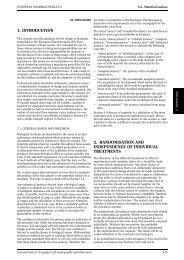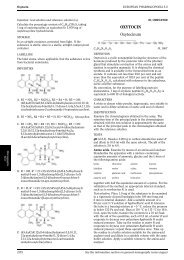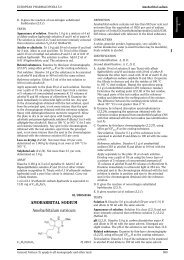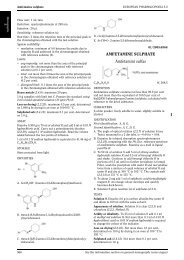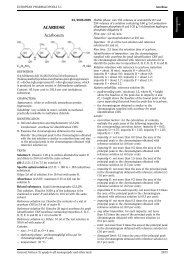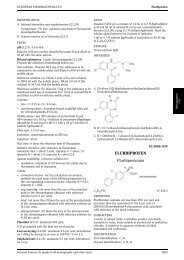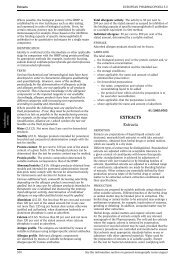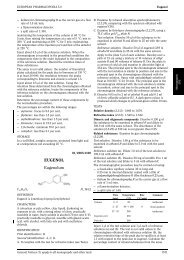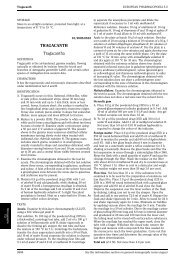DROPERIDOL Droperidolum
DROPERIDOL Droperidolum
DROPERIDOL Droperidolum
You also want an ePaper? Increase the reach of your titles
YUMPU automatically turns print PDFs into web optimized ePapers that Google loves.
EUROPEAN PHARMACOPOEIA 5.0 Droperidol<br />
B.R1=CH3,R2=H:(1RS)-1-phenyl-1-(pyridin-2-yl)ethanol, C. R1=H,R2=CH2-CH2-N(CH3) 2: N,N-dimethyl-2-[(RS)-1phenyl(pyridin-2-yl)methoxy]ethanamine,<br />
D. phenyl(pyridin-2-yl)methanone (2-benzoylpyridine).<br />
<strong>DROPERIDOL</strong><br />
<strong>Droperidolum</strong><br />
01/2005:1010<br />
Reference solution (a). Dissolve 30 mg of droperidol CRS<br />
in a mixture of 1 volume of acetone R and 9 volumes of<br />
methanol R and dilute to 10 ml with the same mixture<br />
of solvents.<br />
Reference solution (b). Dissolve 30 mg of droperidol CRS<br />
and 30 mg of benperidol CRS in a mixture of 1 volume<br />
of acetone R and 9 volumes of methanol R and dilute to<br />
10mlwiththesamemixtureofsolvents.<br />
Apply to the plate 10 µl of each solution. Develop over a<br />
path of 15 cm using a mixture of 1 volume of acetone R<br />
and 9 volumes of methanol R. Allow the plate to dry in air<br />
and examine in ultraviolet light at 254 nm. The principal<br />
spot in the chromatogram obtained with the test solution<br />
is similar in position and size to the principal spot in the<br />
chromatogram obtained with reference solution (a). The<br />
test is not valid unless the chromatogram obtained with<br />
reference solution (b) shows 2 clearly separated spots.<br />
C. Dissolve about 10 mg in 5 ml of ethanol R. Add0.5mlof<br />
dinitrobenzene solution R and 0.5 ml of 2Malcoholic<br />
potassium hydroxide R. Avioletcolourisproducedand<br />
becomes brownish-red after 20 min.<br />
D.Mixabout5mgwith45mgofheavy magnesium oxide R<br />
and ignite in a crucible until an almost white residue is<br />
obtained (usually less than 5 min). Allow to cool, add 1 ml<br />
of water R, 0.05mlofphenolphthalein solution R1 and<br />
about 1 ml of dilute hydrochloric acid R to render the<br />
solution colourless. Filter. To a freshly prepared mixture<br />
of 0.1 ml of alizarin S solution R and 0.1 ml of zirconyl<br />
nitrate solution R, add1.0mlofthefiltrate.Mix,allowto<br />
stand for 5 min and compare the colour of the solution<br />
with that of a blank prepared in the same manner. The<br />
test solution is yellow and the blank is red.<br />
C22H22FN3O2 Mr 379.4<br />
TESTS<br />
Appearance of solution. Dissolve 0.20 g in methylene<br />
chloride R and dilute to 20.0 ml with the same solvent. The<br />
solution is clear (2.2.1) and not more intensely coloured<br />
DEFINITION<br />
than reference solution BY5 (2.2.2, Method II).<br />
Droperidol contains not less than 99.0 per cent and<br />
not more than the equivalent of 101.0 per cent of<br />
1-[1-[4-(4-fluorophenyl)-4-oxobutyl]-1,2,3,6-tetrahydropyridin-<br />
4-yl]-1,3-dihydro-2H-benzimidazol-2-one, calculated with<br />
reference to the dried substance.<br />
Related substances. Examinebyliquidchromatography<br />
(2.2.29). Prepare the solutions immediately before use.<br />
Test solution. Dissolve0.10gofthesubstancetobe<br />
examined in dimethylformamide R and dilute to 10.0 ml<br />
with the same solvent.<br />
CHARACTERS<br />
Reference solution (a). Dissolve 2.5 mg of droperidol CRS<br />
A white or almost white powder, practically insoluble in<br />
water, freely soluble in dimethylformamide and in methylene<br />
and 2.5 mg of benperidol CRS in dimethylformamide R and<br />
dilute to 100.0 ml with the same solvent.<br />
chloride, sparingly soluble in alcohol.<br />
Reference solution (b). Dilute 1.0 ml of the test solution to<br />
It shows polymorphism.<br />
100.0 ml with dimethylformamide R. Dilute 5.0 ml of this<br />
IDENTIFICATION<br />
First identification: A.<br />
Second identification: B, C, D.<br />
A. Examine by infrared absorption spectrophotometry<br />
(2.2.24), comparing with the spectrum obtained with<br />
droperidol CRS. Examine the substances prepared as<br />
discs. If the spectra obtained show differences, dissolve<br />
solution to 20.0 ml with dimethylformamide R.<br />
The chromatographic procedure may be carried out using:<br />
— a stainless steel column 0.10 m long and 4.6 mm<br />
in internal diameter packed with base-deactivated<br />
octadecylsilyl silica gel for chromatography R (3 µm),<br />
— as mobile phase at a flow rate of 1.5 ml/min:<br />
mobile phase A: acetonitrile R,<br />
the substance to be examined and the reference substance mobile phase B: 10g/lsolutionoftetrabutylammonium<br />
separately in the minimum volume of acetone R,<br />
hydrogen sulphate R1,<br />
evaporate to dryness on a water-bath and record new<br />
spectra using the residues.<br />
B. Examine by thin-layer chromatography (2.2.27), using<br />
silica gel GF254 R as the coating substance.<br />
Time<br />
(min)<br />
0-15<br />
Mobile phase A<br />
(per cent V/V)<br />
0 → 40<br />
Mobile phase B<br />
(per cent V/V)<br />
100 → 60<br />
Test solution. Dissolve 30 mg of the substance to be<br />
15 - 20 40 60<br />
examined in a mixture of 1 volume of acetone R and<br />
9 volumes of methanol R and dilute to 10 ml with the<br />
20 - 25 40 → 0 60 → 100<br />
same mixture of solvents.<br />
— as detector a spectrophotometer set at 275 nm.<br />
GeneralNotices(1)applytoallmonographsandothertexts 1487
Droperidol EUROPEAN PHARMACOPOEIA 5.0<br />
Adjust the sensitivity of the system so that the height of the<br />
principal peak in the chromatogram obtained with 10 µl of<br />
reference solution (b) is at least 50 per cent of the full scale<br />
of the recorder.<br />
Inject10µlofreferencesolution(a). Whenthechromatogram<br />
is recorded in the prescribed conditions, the retention times<br />
are: benperidol about 6.5 min and droperidol about 7 min.<br />
The test is not valid unless the resolution between the peaks<br />
due to droperidol and benperidol is at least 2.0. If necessary,<br />
adjust the final concentration of acetonitrile in the mobile<br />
phase or adjust the time programme for the linear gradient.<br />
Inject 10 µl of dimethylformamide R as a blank, 10 µl of<br />
thetestsolutionand10µlofreferencesolution(b).Inthe<br />
chromatogram obtained with the test solution: the area<br />
of any peak, apart from the principal peak, is not greater<br />
than the area of the principal peak in the chromatogram<br />
obtained with reference solution (b) (0.25 per cent); the<br />
sumoftheareasofallthepeaks,apartfromtheprincipal<br />
peak,isnotgreaterthantwicetheareaoftheprincipalpeak<br />
in the chromatogram obtained with reference solution (b)<br />
(0.5 per cent). Disregard any peak obtained with the blank<br />
and any peak with an area less than 0.2 times the area of the<br />
principal peak in the chromatogram obtained with reference<br />
solution (b).<br />
Heavy metals (2.4.8). 1.0 g complies with limit test D for<br />
heavy metals (20 ppm). Prepare the standard using 2 ml of<br />
lead standard solution (10 ppm Pb) R.<br />
Loss on drying (2.2.32). Not more than 0.5 per cent,<br />
determined on 1.000 g by drying in an oven at 100-105 °C.<br />
Sulphated ash (2.4.14). Not more than 0.1 per cent,<br />
determined on 1.0 g.<br />
ASSAY<br />
Dissolve0.300gin50mlofamixtureof1volumeof<br />
anhydrous acetic acid R and 7 volumes of methyl ethyl<br />
ketone R. Using0.2mlofnaphtholbenzein solution R,<br />
titrate with 0.1 M perchloric acid until the colour changes<br />
from orange-yellow to green.<br />
1mlof0.1Mperchloric acid is equivalent to 37.94 mg of<br />
C22H22FN3O2. STORAGE<br />
Store protected from light.<br />
IMPURITIES<br />
A. 1-(1,2,3,6-tetrahydropyridin-4-yl)-1,3-dihydro-2Hbenzimidazol-2-one,<br />
B. 1-[1-[4-(2-fluorophenyl)-4-oxobutyl]-1,2,3,6tetrahydropyridin-4-yl]-1,3-dihydro-2H-benzimidazol-2one,<br />
C. 1-[4-(4-fluorophenyl)-4-oxobutyl]-4-(2-oxo-2,3-dihydro-1Hbenzimidazol-1-yl)pyridinium<br />
chloride,<br />
D. (1RS)-1-[4-(4-fluorophenyl)-4-oxobutyl]-4-(2-oxo-2,3dihydro-1H-benzimidazol-1-yl)-1,2,3,6-tetrahydropyridine<br />
1-oxide,<br />
E. 1-[1-[4-[4-[4-(2-oxo-2,3-dihydro-1H-benzimidazol-1-yl)-3,<br />
6-dihydropyridin-1(2H)-yl]-1-oxobutyl]phenyl]-1,2,3,6tetrahydropyridin-4-yl]-1,3-dihydro-2H-benzimidazol-2one.<br />
1488 See the information section on general monographs (cover pages)



